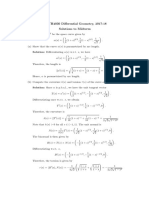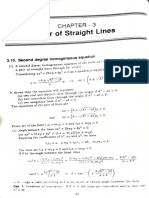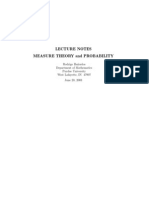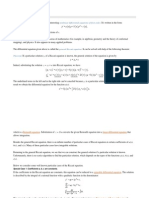Riemann Method For Hyperbolic Equations
Uploaded by
shaz_donRiemann Method For Hyperbolic Equations
Uploaded by
shaz_donBasic Concepts
1. Hyperbolic Equations[1]
A partial differential equation of second order, i.e., one of the form
Auxx + 2Buxy + Cuyy + Dux + Euy +F = 0
is called hyperbolic if
B 2 - 4AC < 0
Example: The one dimensional wave equation:
utt - c2 uxx = 0
is an example of a hyperbolic equation.
2. Riemann Function[2]
The Riemann function R(x, y; , ) is defined as the solution of the equation
Rxy - (aR)x - (bR)y + cR = 0
which satisfies the conditions
y
Z
R(, y; , ) = exp[
a(, t) dt]
and
Z
R(x, ; , ) = exp[
b(t, ) dt]
on the characteristics x = and y = , where (, ) is a point on the domain
on which the conditions state above are defined. The solution is then given by the
Riemann formula
Z
u(x, y) =
Z
d
R(, ; x, y)f (, ) d
1
This method of solution is called the Riemann method.
3. Greens theorem[3]
Let C be a positively oriented, piecewise smooth, simple closed curve in a plane,
and let D be the region bounded by C. If L and M are functions of (x, y) defined
on an open region containing D and have continuous partial derivatives there, then
Z
ZZ
L
M
) dx dy
(L dx + M dy) =
(
y
C
D x
where the path of integration along C is counterclockwise.
4. Adjoint Equation[4]
The adjoint equation is applicable to linear differential equations which yield
a linear differential equation of a lower order. For every solution of the adjoint
equation we can find, we can reduce the order of the original equation by one.
1
5. Adjoint Linear Operators[5]
To a linear operator L, defined by
L(u) = auxx + 2huxy + buyy + 2gux + 2f uy + cu
where the coefficients are continuously differentiable functions of x and y alone,
there corresponds a unique linear operator L , called the adjoint of L, such that
vL(u) - uL (v) is a divergence.
If D is a domain whose boundary is a regular closed curve C, it follows by Greens
theorem that
ZZ
Z
(vL(u) uL (v)) dx dy =
(lH + mK) ds
D
where (l, m) are direction cosines of the outward normal to C.
After doing some calculations and subsequent simplifications, we get,
L (v) = (av)xx + 2(hv)xy + (bv)yy 2(gv)x 2(f v)y + cv
where
H = avux u(av)x + hvuy u(hv)y + 2guv
K = hvux (hv)x + bvuy u(bv)y + 2f uv
H and K are not unique; we can add to them /y and -/x respectively; but
L is unique and the adjoint of L is L.
L is said to be self-adjoint if L = L. The condition for this is
ax + hy = 2g, hx + by = 2f
so that a self-adjoint operator can be written in the form
(aux ) +
(huy ) +
(hux ) +
(buy ) + cu
x
x
y
y
Riemann Method
6. Use[4]
The Riemanns method is applicable to linear hyperbolic equations of the
second order in two independent variables which yields an exact solution in terms
of the solution to the adjoint equation.
7. Idea[4]
The solution of a non-characteristic initial value problem in two dimensions can
be found if the adjoint equation with specific boundary conditions can be solved.
8. Essentials of Riemann Method[6]
The solution of the problem of Cauchy given by Riemann for the partial differential equation
(1)
uxy - a(ux uy ) = 0, a = a(x, y)
has been extended to the general linear partial differential equation of second order
in two independent variables x, y,
(2)
uxy + aux + buy + cu = f
where a, b, c, f are given functions of x, y.
For the sake of simplicity we consider the equations of the type
(3)
L(u) = uxy - aux - buy = 0, a = a(x, y), b = b(x, y)
Actually, if a solution u1 of (2) and a solution u0 of the homogeneous equation
(f = 0) are known, equation (2) can always be reduced to one of type (3) for a new
unknown function u defined by u = u1 + u0 u.
The classical procedure associates with (3) its adjoint equation
(4)
M (v) = vxy + (av)x + (bv)y = 0
and is based on the differential identity
(5)
Ax + By = vL(u) - uM (v), where A =
(vuy uvy )
2
- auv, and B =
(vux uvx )
2
- buv
The identity implies that the line integral
Z
I = (B dx A dy)
vanishes around closed paths lying in the interior of a domain D within which the
function u, v are regular solutions of L(u) = 0 and M (v) = 0, respectively.
The line integral I vanishes around closed paths leads immediately to the solution
of Cauchys problem for (3). Let C be an arc meeting any horizontal or vertical
line in at most one point. Along C the values of ux , uy (Cauchys data) for the
solution of (3) are given.
In order to calculate the value u(P ) of the solution at the point P in the figure, the
line integral I is evaluated around the closed path P XY P formed by the horizontal
line segment P X, the arc XY of C, and the vertical line segment Y P . One finds
(6)
RY
RX
RP
B(x, y) dx + X (B dx A dy) - Y A(x, y) dy = 0
P
If a solution v = v(x, y; x, y) of M (v) = 0 can be found for which
(7)
vx = -bv on y = y, vy = -av on x = x and v(x, y; x, y) = 1
hold on the characteristics x = x and y = y through P , we shall have
(8)
A(x, y) = (uv)y /2 and B(x, y) = (uv)x /2
and consequently (6) will yield
(9)
RY
u(P ) = 21 [u(X)v(X) + u(Y )v(Y )] + X (B dx A dy)
The function v is known as Riemanns function, and, once it has been determined, u(P ) may be calculated from (9) from the knowledge of Cauchy data along
C.
The first step in Riemanns method is the formulation of the line integral I
so that it vanishes around closed paths. We note that the coefficients A, B of
the differentials are bilinear forms in two set of variables u, ux , uy and v, vx , vy .
Furthermore, the real reason for the introduction of adjoint equation (4) and its
solution v is to make available the identity (5), which guarantees that I vanishes
around closed paths.
9. A more general case[5]
Consider the following equation
L(u) = 2uxy + 2gux + 2f uy + cu = F (x, y)
given u, ux , uy on some duly rectangular arc C. The data satisfy the strip condition
du = ux dx + uy dy on C. The functions g, f , c, F are assumed to be continuously
differentiable functions of x and y alone.
Let the characteristics y = y0 and x = x0 through P (x0 , y0 ) cut C in Q and
R respectively. Let D be the domain bounded by P Q, P R and C; let be its
boundary. Then, if L(u) = F , L (v) = 0, we have
ZZ
ZZ
(vL(u) uL (v)) dx dy =
vF dx dy =
D
ZZ
[
D
H K
+
] dx dy =
X y
Z
(K dx+H dy)
where
H = avux - u(av)x + hvuy - u(hv)y + 2guv
and
K = hvux - (hv)x + bvuy - u(bv)y + 2f uv
by Greens theorem, assuming that u and v have continuous second derivatives.
Using the aforementioned values of H and K, the integral round is equal to
Z
Z
Z
[(vu)x 2u(vx f v)] dx +
(K du + H dy) +
[(vu)y 2u(vy gv)] dy
PQ
QR
RP
Z
= 2(uv)P (uv)Q (uv)R +
(K dx + H dy)
QR
provided that
vx f v = 0 when y = y0
vy gv = 0 when x = x0
that is, provided that
Z
v(x, y0 ) = exp
f (, y0 ) d
x0
and
Z
v(x0 , y) = exp
g(x0 , ) d
y0
where we have taken v(x0 , y0 ) to be unity, as we may without the loss of generality.
Hence v is given by a characteristic boundary value problem for L (v) = 0.
This problem has a solution, the Riemann-Green function, which we denote by
v(x, y; x0 , y0 ). If Q is (x1 , y0 ), and R is (x0 , y1 ), it follows that
1
1
u(x0 , y0 ) = u(x1 , y0 )v(x1 , y0 ; x0 , y0 ) + u(x0 , y1 )v(x0 , y1 ; x0 , y0 )
2
2
Z
ZZ
1
1
(K dx H dy) +
v(x, y; x0 , y0 )F (x, y) dx dy
2 QR
2
D
This is the required solution, since
H = vuy - uvy + 2guv and K = uvx - vux + 2f uv
are given on QR by the Cauchy data.
10. Determination of the Riemann-Green function[5]
The difficulty in Riemanns solution is the determination of the Riemann-Green
function. The method replaces a Cauchy problem by a characteristic boundary
value problem.
It suffices to consider the case when independent variables are characteristic
variables, so that the linear operator is
L(u) = 2uxy + 2gux + 2f uy + c
If we make the change of dependent variable u = U , and divide through by , we
get a linear operator
M (U ) = 2Uxy + 2GUx + 2F Uy + CU
where
G=g+
F =f+
and
and
C = c + 2g
x
y
xy
+ 2f
+
The Riemann-Green function for L(u), v(x, y; x0 , y0 ), satisfies the adjoint equation
L (u) = 0 and the conditions
vx = f v on y = y0 , vx = gv on x = x0
and
v(x0 , y0 ; x0 , y0 ) = 1
It follows that the Riemann-Green function for M (U ) = 0 is
V (x, y; x0 , y0 ) =
(x, y)
v(x, y; x0 , y0 )
(x0 , y0 )
For example, if we put u = (x + y)U in uxy = 0, for which the Riemann-Green
function is constant, we get
Uxy +
Ux + Uy
=0
x+y
for which the Riemann-Green function is therefore
V (x, y; x0 , y0 ) =
x+y
x0 + y0
The change of dependent variable is useful if we can choose so that M (U ) = 0 is
self-adjoint. This occurs if
log, g = - y
log
f = - x
such a transformation is thus possible when gx = fy .
The Riemann-Green function is the solution of a characteristic boundary value
problem, and does not depend in any way on the arc carrying the Cauchy data. If
it is possible to solve by some other method the problem of Cauchy with a simple
curve carrying the data, a comparison of this solution and the Riemann solution
should give the Riemann-Green function. In the case of the two equations discussed
by Riemann, it was possible to do this; he solved the problem of Cauchy with data
on a straight line by using Fourier cosine transforms.
11. An Example[4]
Consider the following partial differential equation (E1)
2 w 2 w = 0
w(, 1) = f ()
w (, 1) = g()
where - < < , 1 < < , and f () and g() are given functions. If we
change variables in equation (E1) from {w, , } to {u, x, y} by
u(x, y) = w(, )
x = and y =
Now, equation (E1) becomes upon doing the transformations stated above
(10)
1
uxy - 2x
uy = 0
The boundary conditions in equation (E1) transform to
(11)
u(s, 1s ) = f (s) and sux (s, 1s ) + 1s uy (s, 1s ) = g(s)
where < s < . By manipulations of equation (11), we can derive the following
set of equations (E2),
1
u(s, ) = f (s)
s
1
1
1
ux (s, ) = [f 0 (s) + g(s)]
s
2
s
1
1
uy (s, ) = [sg(s) s2 f (s)]
s
2
The domain in which equations (10) and (E2) are to be solved is shown in this figure.
To solve equations (10) and (E2), we use Riemanns method. Comparing equation (10) to L[u] = uxy + a(x, y)ux + b(x, y)uy + c(x, y)u = f (x, y), we determine
a = 0, b = 1/2x, c = 0, f = 0
The Riemanns method gives solution of the form
Z Q
ZZ
1
1
u(, ) = R(P ; , )u(P ) + R(Q; , )u(Q)
B[u(x, y), R(x, y; , )] +
f (x, y)R(x, y; , ) dx dy
2
2
P
D
This formula is valid when we wish to find u(S) = u(, ), where S represents an
arbitrary point as shown in the figure below. If we assume that the initial curve
is monotonically decreasing then we can write the solution in the above stated
form. Here, P and Q are as shown in the figure below.
Coming back to our problem at hand (10), we can write the solution (E3) as follows
Z Q
1
1
1
1
1
1
1
u(, ) = R(P ; , )u(P ) + R(Q; , )u(Q)
[( Ruy Ry u) dy ( Ru + Rux Rx u) dx]
2
2
2
2
2x
2
2
P
All that remains to find the Riemanns function. Using equations from section 2,
we say that R(x, y; , ) satisfies (E4)
1
Ry = 0
Rxy +
2x
R(, y; , ) = 1
r
R(x, y; , ) =
x
R(, ; , ) = 1
Because the first equation of (E4) can be integrated directly with respect to x and
then with respect to y the general solution to equation (E4) is easily seen to be of
the form
(12)
R(x, y; , ) = M (x; , ) + K(y;,)
x
for some M (x; , ) and some K(y; , ). Using equation (12) in the boundary
conditions in the set of equations (E4), the solution is found to be
(13)
q
R(x, y; , ) =
Using equation (13) in equation (E3), we can find u(, ) and hence, w(, ) for
any values of and .
12. Riemann Zeta Function[7]
The Riemann zeta function, (s), is a function of a complex variable s that
analytically continues the sum of infinite series
X
1
n=1
ns
which converges when the real part of s is greater that 1. The Riemann zeta function plays a pivotal role in analytic number theory and has applications in physics,
probability theory, and applied statistics.
Definition: The Riemann zeta function (s) is a function of a complex variable s
= + t.
The following infinite series converges for all complex numbers s with real part
greater than 1, and defines (s) in this case:
X
1
(s) =
ns
n=1
where = R(s) > 1
It can also be defined by the integral
Z s1
1
x
(s) =
dx
(s) 0 ex 1
The Riemann zeta function is defined as the analytic continuation of the function
defined for > 1 by the sum of preceding series.
10
References
[1]
[2]
[3]
[4]
[5]
[6]
[7]
Wolfram Mathworld: Hyperbolic Partial Differential Equations
Wolfram Mathworld: Riemann Function
Wikipedia: Greens Theorem
Zwillinger D. (1997), Handbook of Differential Equations 3rd edition, Academic Press
Copson E.T., Partial Differential Equations, Cambridge University Press 1975
Martin M.H., Riemanns Method and the Problem of Cauchy, University of Maryland
Wikipedia: Riemann Zeta Function
You might also like
- MATH4030 Differential Geometry, 2017-18 Solutions To MidtermNo ratings yetMATH4030 Differential Geometry, 2017-18 Solutions To Midterm5 pages
- Theory of Interest Kellison Solutions Chapter 011100% (1)Theory of Interest Kellison Solutions Chapter 01115 pages
- Lecture Notes (Chapter 1.2 Limit and Continuity) PDF100% (1)Lecture Notes (Chapter 1.2 Limit and Continuity) PDF5 pages
- 2.5: Numerical Integration - Midpoint, Trapezoid, Simpson's RuleNo ratings yet2.5: Numerical Integration - Midpoint, Trapezoid, Simpson's Rule8 pages
- An Elementary Treatise On Differential ENo ratings yetAn Elementary Treatise On Differential E301 pages
- Strassen's 2 × 2 Matrix Multiplication Algorithm: A Conceptual PerspectiveNo ratings yetStrassen's 2 × 2 Matrix Multiplication Algorithm: A Conceptual Perspective6 pages
- Math 38 Mathematical Analysis III: I. F. EvidenteNo ratings yetMath 38 Mathematical Analysis III: I. F. Evidente72 pages
- Partial Differential Equations: Methods and ApplicationsNo ratings yetPartial Differential Equations: Methods and Applications6 pages
- Asymptotes, Holes, and Graphing Rational FunctionsNo ratings yetAsymptotes, Holes, and Graphing Rational Functions4 pages
- A. Approximations: 1. The Linear Approximation LinearizationsNo ratings yetA. Approximations: 1. The Linear Approximation Linearizations7 pages
- Analytic Inequalities - Mitrinovic, Dragoslav S., (Springer, 1970)No ratings yetAnalytic Inequalities - Mitrinovic, Dragoslav S., (Springer, 1970)416 pages
- Ullrich D. C. - Complex Made Simple (2008) Errata PDFNo ratings yetUllrich D. C. - Complex Made Simple (2008) Errata PDF4 pages
- Complex Variables Introduction and Applications 2nd Edition Mark J. Ablowitz all chapter instant download100% (5)Complex Variables Introduction and Applications 2nd Edition Mark J. Ablowitz all chapter instant download61 pages
- 093 - MA8353 Transforms and Partial Differential Equations - NotesNo ratings yet093 - MA8353 Transforms and Partial Differential Equations - Notes73 pages
- Math - de Moivre Theorem by DR D K Yadav As On 30.03.20 MinNo ratings yetMath - de Moivre Theorem by DR D K Yadav As On 30.03.20 Min23 pages
- Complete Answer Guide for Thomas Calculus Early Transcendentals 13th Edition Thomas Solutions Manual100% (9)Complete Answer Guide for Thomas Calculus Early Transcendentals 13th Edition Thomas Solutions Manual66 pages
- Analytic Functions Necessary and Sufficient Condition: Cauchy-Riemann EquationsNo ratings yetAnalytic Functions Necessary and Sufficient Condition: Cauchy-Riemann Equations58 pages
- Power Series Solution and Frobenius Method: (Mathematical Physics Assignment)No ratings yetPower Series Solution and Frobenius Method: (Mathematical Physics Assignment)22 pages
- Liquid Crystals: Their Structure Is Somewhere Between That of Crystalline Materials and LiquidsNo ratings yetLiquid Crystals: Their Structure Is Somewhere Between That of Crystalline Materials and Liquids1 page
- Fluids: A Fluid Is Something Which Cannot Sustain Shear StressNo ratings yetFluids: A Fluid Is Something Which Cannot Sustain Shear Stress1 page
- MATH4030 Differential Geometry, 2017-18 Solutions To MidtermMATH4030 Differential Geometry, 2017-18 Solutions To Midterm
- Lecture Notes (Chapter 1.2 Limit and Continuity) PDFLecture Notes (Chapter 1.2 Limit and Continuity) PDF
- 2.5: Numerical Integration - Midpoint, Trapezoid, Simpson's Rule2.5: Numerical Integration - Midpoint, Trapezoid, Simpson's Rule
- Strassen's 2 × 2 Matrix Multiplication Algorithm: A Conceptual PerspectiveStrassen's 2 × 2 Matrix Multiplication Algorithm: A Conceptual Perspective
- Partial Differential Equations: Methods and ApplicationsPartial Differential Equations: Methods and Applications
- Asymptotes, Holes, and Graphing Rational FunctionsAsymptotes, Holes, and Graphing Rational Functions
- A. Approximations: 1. The Linear Approximation LinearizationsA. Approximations: 1. The Linear Approximation Linearizations
- Analytic Inequalities - Mitrinovic, Dragoslav S., (Springer, 1970)Analytic Inequalities - Mitrinovic, Dragoslav S., (Springer, 1970)
- Ullrich D. C. - Complex Made Simple (2008) Errata PDFUllrich D. C. - Complex Made Simple (2008) Errata PDF
- Complex Variables Introduction and Applications 2nd Edition Mark J. Ablowitz all chapter instant downloadComplex Variables Introduction and Applications 2nd Edition Mark J. Ablowitz all chapter instant download
- 093 - MA8353 Transforms and Partial Differential Equations - Notes093 - MA8353 Transforms and Partial Differential Equations - Notes
- Math - de Moivre Theorem by DR D K Yadav As On 30.03.20 MinMath - de Moivre Theorem by DR D K Yadav As On 30.03.20 Min
- Complete Answer Guide for Thomas Calculus Early Transcendentals 13th Edition Thomas Solutions ManualComplete Answer Guide for Thomas Calculus Early Transcendentals 13th Edition Thomas Solutions Manual
- Analytic Functions Necessary and Sufficient Condition: Cauchy-Riemann EquationsAnalytic Functions Necessary and Sufficient Condition: Cauchy-Riemann Equations
- Power Series Solution and Frobenius Method: (Mathematical Physics Assignment)Power Series Solution and Frobenius Method: (Mathematical Physics Assignment)
- Liquid Crystals: Their Structure Is Somewhere Between That of Crystalline Materials and LiquidsLiquid Crystals: Their Structure Is Somewhere Between That of Crystalline Materials and Liquids
- Fluids: A Fluid Is Something Which Cannot Sustain Shear StressFluids: A Fluid Is Something Which Cannot Sustain Shear Stress
































































